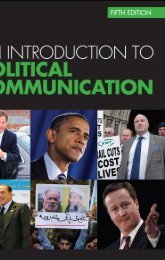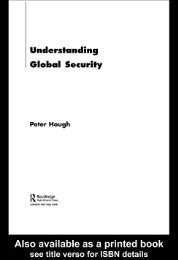Oratie Duyvesteijn Eng
Oratie Duyvesteijn Eng
Oratie Duyvesteijn Eng
You also want an ePaper? Increase the reach of your titles
YUMPU automatically turns print PDFs into web optimized ePapers that Google loves.
8<br />
in the garbage. 26 The widespread idea was that the advent of<br />
nuclear weapons had made all hitherto available knowledge on<br />
strategy obsolete. What motivated Brodie particularly was the<br />
fact that the quality of analysis that political decision-makers<br />
had to work with left lots to be desired. 27 The geopolitical<br />
landscape was clear and an actual military conflict held the<br />
risk of nuclear escalation. Thinking about strategy went into<br />
the abstract; Deterrence theory, escalation ladders and secondstrike<br />
capabilities. The escalation ladder of Herman Kahn had,<br />
for example, 44 rungs, the last one being all out nuclear war.<br />
Whereas in the early years of the Cold War, strategy was<br />
approached as a science, this changed at the end of the<br />
nineteen seventies. After the failures of Vietnam and the<br />
recognition of the shortcomings in thinking about armed<br />
struggle, there was more attention for war as art. There was<br />
a Clausewitz revival and a second generation of strategic<br />
thinkers appeared. They were responsible for the so-called<br />
‘empirical turn’ with more emphasis on historical research.<br />
With Hedley Bull ahead of the troops, they argued for the<br />
study of history as a source of sound strategic thinking. There<br />
was a recognition of the limitations of the rational actor<br />
model that assumed that actors are always rational and weigh<br />
costs and benefits and an appreciation for the role of history<br />
and culture. Except for the ideas about limited warfare in the<br />
fifties, as a result of the Korean war, hardly any thought had<br />
been devoted to conventional war. Strategic thinking at this<br />
point was recaptured by the military from the civilian thinkers<br />
through the discovery or development of the operational level<br />
of war. Here soldiers could get back to the essence of their<br />
trade, how to wage an armed struggle<br />
This could not prevent, however, that at the end of the Cold<br />
War, the field of strategic studies was left practically emptyhanded.<br />
The focus during the previous five decades had been<br />
strongly focused on international conflict, while at the start<br />
of the nineties, the greatest threat was posed by civil war and<br />
internal conflicts. The accusations were fundamental, insights<br />
and theories of civil wars were conspicuously absent. At<br />
first these civil wars were even placed outside the utilitarian<br />
Clausewitzean paradigm and described as barbarism. 28<br />
War as a true chameleon<br />
The lack of recognition that the essence of these civil wars<br />
also constituted of violence, a political purpose and a direct<br />
relationship between these two, cost us dearly. There was no<br />
appeal to strategic or operational thought. It is inevitable<br />
that if you are physically present, placed between the warring<br />
parties, protecting aid convoys and facilitating elections<br />
that you form a party, if only in the perception of the other<br />
belligerents. Impartial help to resolve a conflict proved to be a<br />
myth, it imparts a very normative agenda, based on the idea of <br />
a compromise peace and democratic elections, which should<br />
contribute to the establishment of a stable political order. The<br />
translation into military feasible plans left lots to be desired. 29<br />
There was hardly any strategic thinking even in the more<br />
conventional wars. While the 1991 Iraq war showed a clear<br />
political-military interface in the removal of the Iraqi<br />
occupation forces from Kuwait by defeating the Iraqi armed<br />
forces with airstrikes and a short war of attrition in Iraq itself.<br />
The causes of the political problem, the expansionist policies<br />
of Saddam Hussein, his alleged weapons of mass destruction<br />
stockpile and his lack of respect for human rights, lead to a<br />
new war in 2003.<br />
Here we see again the tendency, as a result of the partial success<br />
of 1991, at least in an operational sense, to elevate lessons<br />
into science. The so-called revolution in military affairs at the<br />
beginning of the nineties on the basis of technological and<br />
tactical superiority are yet another expression of the Jominian<br />
ideas of war. With the use of appropriate technological means,<br />
automatically the desired effect could be reached. 30 Also ideas,<br />
popular at this time, such as effects-based operations and<br />
network-centric approaches, still showed echoes of Jomini. 31<br />
Prof.dr. I.G.B.M. Duyvesteyn
















